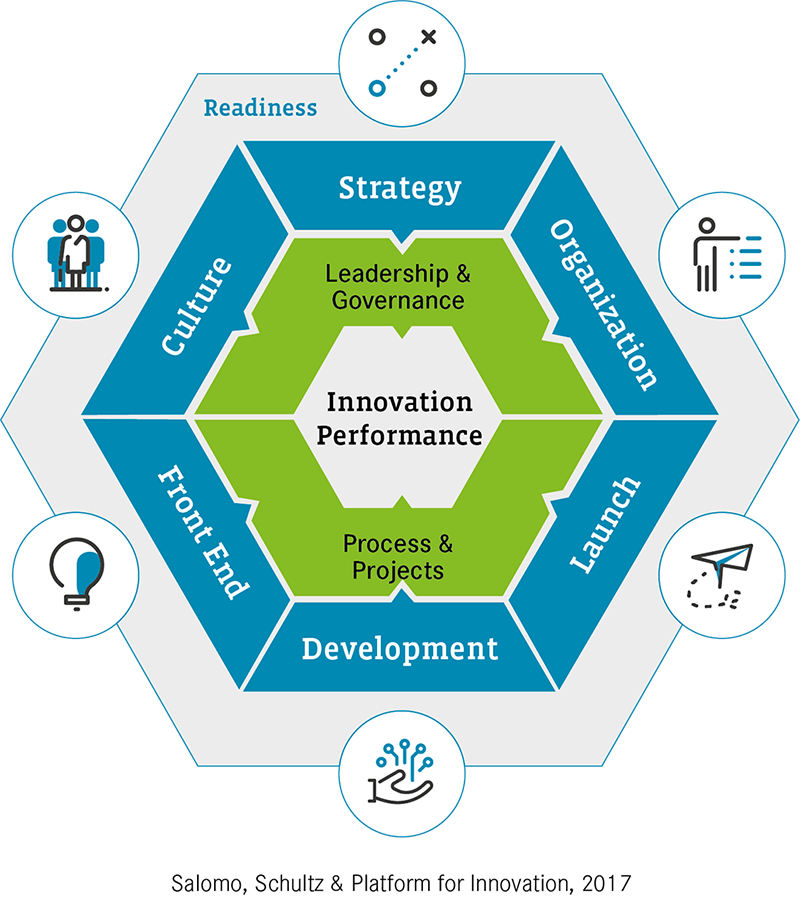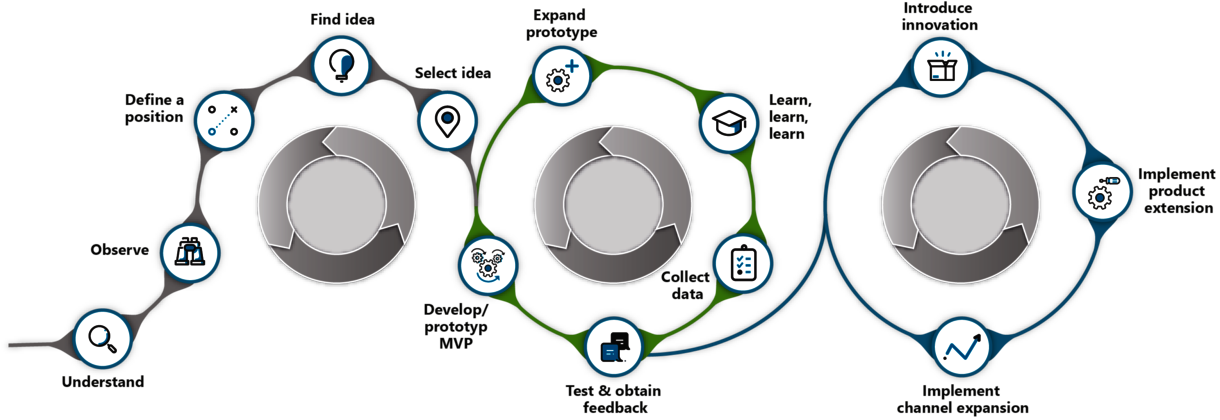The consequences of the corona crisis affect the entire global economy, and its impact has been felt by every single industry in one way or another. Every company is asking itself how it can best overcome the crisis, and perhaps even emerge stronger as a result.
To this end, it is important that they observe the behavior patterns of end customers and analyze how these continue to develop. This is only way to create structures that can address customer requirements over the long term. Integrated innovation management (with external partners if required) can provide a decisive competitive advantage in this context.
But how is that even possible, in a time when many companies are fighting for their survival? With the help of an intelligent innovation management system that is adapted to the changing external circumstances. It means that companies can emerge from the crisis as winners and distinguish themselves from more timid competitors.
The crisis has shown that companies are afraid of making large investments or developing new products or services and introducing them in the market. Most of them respond with an abundance of caution and tend to postpone or even reduce investments in innovation. For this reason, many companies will probably be in a weaker position during the ramp-up phase after the crisis. That can become a major disadvantage.
What are the most important issues right now?
Before turning to state-of-the-art innovation management to develop new products or services, companies must know their own status quo situation. They can do this with an assessment that uses an Innovation Excellence Model. It distinguishes between six dimensions. Together, the dimensions culture, strategy and organization represent the general environment that promotes innovation. The dimensions initiation, development and market introduction represent the innovation process in a more narrow sense. The first important steps target initiation and development.
In every case, this could be the right time for companies to reach new market segments or gain new market share with investments in innovation, while competitors are still more tentative. With a view to the innovation budget, a balanced approach is recommended, i.e. do not focus exclusively on the core business or on the adjacent business divisions.
Because of the current situation, it is more important than ever that innovation management activities are as targeted, efficient and cost-effective as possible. This can be done with a systematic innovation process. In best practices, the DARE model has proven to be very successful for initiating and developing innovations. It has been derived and optimized by Campana & Schott following many years of application in innovation projects with our customers as well as cooperations with innovation management chairs at universities.
The innovation process – using the DARE model
The efficient introduction of profitable innovations requires a systematic innovation process. The lack of structure for generating and developing ideas and implementing them into successful solutions hinders the utilization of the company's innovation potential. The absence of standards and methods during the entire process can result in bad investments in unprofitable ideas and prevent experience gains. Establish a systematic innovation process with an appropriate degree of formalization, clear phases, milestones and methods to guarantee the efficient development of innovations.
The DARE model divides the innovation process into three phases, whereby “discover & activate” and “realize” correspond to the process of initiation and development in the Innovation Excellent Model in a wider sense. These two dimensions are particularly relevant for restarting the corporate innovation process after the crisis, therefore they are discussed in more detail below.
This phase of the innovation process is all about generating new ideas. The main goal is to quickly identify and better understand customer requirements, so that the products that are developed can provide the highest possible value for the customer. Proven methods for reaching this goal include customer surveys, workshops or interviews, the preparation of customer personas or customer journeys, as well as research about markets and competitors. Using crowd-sourcing to generate ideas is another possible approach.
In general, it is recommended that companies continuously engage in trend research and proprietary rights research in their core and adjacent business areas, so they are not surprised by new developments and technologies. Similarly, it is also very important to establish a structured process for inviting, collecting and assessing innovation ideas submitted by employees, and their understanding of the current market situation. Market and competitor analyses provide a data basis for generating innovative ideas and help with making decisions about their profitability.
To this end, the market understanding that is developed from the data basis must be easy to understand and easily accessible to all employees in the company. Either employees should be incentivized to submit independent information, or communication should be directed at them regularly on the Intranet. Easy access to this data is essential for employees who are involved in innovation management.
Employees who have a good understanding of the market find it easier to deal with their customers and their needs, and to contribute their own ideas. Other methods for generating ideas may include idea competitions or hackathons in the company or with external involvement. This approach can also be used for researching customer requirements. A good understanding of the market promotes a long-term outlook with regard to customer satisfaction, and also reduces the response time to new developments in the market.
When innovative ideas are developed in a company, it is essential that they are structured in a formalized and systematic manner so they can be compared during the selection and decision-making process. Clear selection criteria (e.g. profitability) must be defined in accordance with a business case that must be created for each idea, so that decisions can be made as to whether the ideas should be continued. In addition, all relevant stakeholders and possible sponsors in the company must also be included, since in the ideal case every innovation project is implemented as a project with an allocated budget, resources and schedule.
If at the end of the initiation phase the stakeholders decide to proceed with one or more ideas, you have reached the next phase in the innovation process. To ensure that as little time and money as possible is spent on developing products or services that do not meet customer requirements and therefore are not profitable, it is recommended that prototypes are rapidly developed and tested with the customer in iterative cycles. In this way, acceptance of the innovation in the market can be verified as early as possible.
In terms of concept development, it makes sense to initially define the key requirements for the new product or service, the so-called “minimum viable product” (MVP). This process should focus on satisfying hitherto unmet customer requirements, and the value proposition should be designed in such a way that it can be easily discerned by the customer, who sees the advantage compared to other products and competitors and is prepared to honor it with higher prices, for example.
Other aspects that should be considered when redesigning products or services include:
- Degree of customer integration (e.g. through communities, prototype testing or idea mailboxes)
- Approaching alternative customer segments
- Alternative communication and sales channels
- Cooperation with suppliers, sales partners, customers, research institutions and competitors
- Settlement of the service (buy versus lease), design of cost structure and efficiency improvements in internal processes such as billing routines
- Collecting customer's operations/usage data
- Provision of novel services by recombining existing resources and core competencies, and the reorganization of internal and external value chains through e.g. partnerships
- Assessment of risks for the innovation with its consequences and probabilities of occurrence
Where suggestions have been prepared for some of these items, it is not recommended that all are implemented at once, followed by the launch of the supposedly complete product.
Instead, prototypes should be continuously used during the development process for testing and experimentation purposes. Mock-ups based on the current state of development can already be created during earlier phases, at the latest the MVP should be available as a functioning model. Prototypes can be used not just to verify assumptions and demonstrate concepts; rather, systematic customer surveys/observations can also be used to obtain assessments and feedback about acceptance and the product’s market potential. Negative feedback about a developed product means that one should not be afraid to abort the development process at this stage. Because it is exactly in such cases that iterative product development processes result in enormous cost savings.


